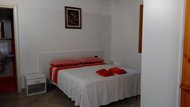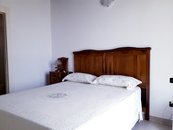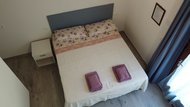Agriturismo Cascina Lert
Via Grumello, 25054 Marone (Brescia) Code 017106-AGR-00002
Profile
In brief
- Type: Bedroom (5), Flat (1),
- Guests: 24
- Map: Hills, Lake
- Type of accommodation: Room only, Bed & Breakfast
The agriturismo
Cascina Lert is situated on the scenic hills of Lake Iseo, in the municipality of Marone at an elevation of 450 msl, surrounded by olive groves, with a breathtaking view of the town of Marone, the lake and its islands particularly Monte Isola and Isola di Loreto
An agritourism with farmers by tradition. "Migrated" from the nearby Val Trompia on Lake Iseo, five generations of goat and cattle breeders have followed, they have remained maintainers of the land and cheesemakers, thanks to the knowledge and stories, passed on by those who learned before them.
On the family farm, where a19th-century farmhouse once stood, they have now built a farm and agritourism with almost all of their own production.
The accommodation
Giulia and Mama Margherita will be happy to welcome you to the farm, for a short guided tour among the animals and the family farms, and then wait for you in the farm shop or in the farm hall, to buy zero-mile products or to taste them, knowing that they are prepared with love by Mama Margherita, in the sign of the typical traditional Brescian cuisine.
Activities and surrounding
History of Marone
The first inhabitants of Marone settled halfway up the coast, in high hamlets set apart from the streams.
In the 1500s the town had a turning point by increasing the use of the port of San Martino, into which flowed timber and coal from the woods that climbed up to Mount Guglielmo. The town of Marone was part of the Christian parish of Sale and became the property of the Benedictine monasteries of Brescia, which began the reclamation of the marshy area.
In 1776 there were already six follies in the village to make blankets, thanks to the presence of follonica earth (yellow clay used to degrease wool) and two looms, which employed about ninety people, while about 180 worked in agriculture.
In the nineteenth century on the initiative of local entrepreneurs, the wool industry, especially cloaks and blankets, developed greatly. At the end of the nineteenth century and in the twentieth century the population increased; after World War II the textile industry declined.
To this day there is still the felt industry combined with the exploitation of dolomite deposits, which has greatly altered the landscape.
The hamlet of Vello
Vello is a picturesque hamlet in a pleasant position between the mountains and Lake Iseo.The Church of the Dead of Vello dates from the 15th century and was the hamlet's parish church; it contains late 15th-century frescoes by Giovanni da Marone (The Annunciation) on the front and inside, while the Romanesque stone bell tower has mullioned windows. The parish church of S. Eufemia, from 1715, contains a canvas by Amiconi from 1647.
Roman villa ruins
A valuable vestige of Maronese antiquity is located in the locality of Vela (Co de Hela - Head of the Villa), where there are extensive remains (about eighty meters) of a Roman building from the 1st century AD, with terraces sloping towards the lake and the floor of a portico with niches for statues.
A large Roman villa, not only residential but also productive dating from the imperial period (1st century AD.) and gradually came to light between 1865, when mosaic floors and sections of aqueduct were found, and the early decades of the 20th century, when sections of walls, a statue of Hercules and still traces of flooring emerged.
A one-meter pedestal with Herculean symbols was found there, now preserved in the Roman museum in Brescia. Many remains were lost due to road and railroad widening work.
Services
Available services
- Theme Parks and Water Parks
- Nature Reserves
- Museums and galleries
- Artistic and historical sites
- Spa
- Hiking
- Fishing
- Horse riding
- Golf
Map
Marone (Brescia) Print directions from host
The telephone number is:
By calling the phone number I declare that I am of age and accept the terms and conditions of use and privacy policy.





